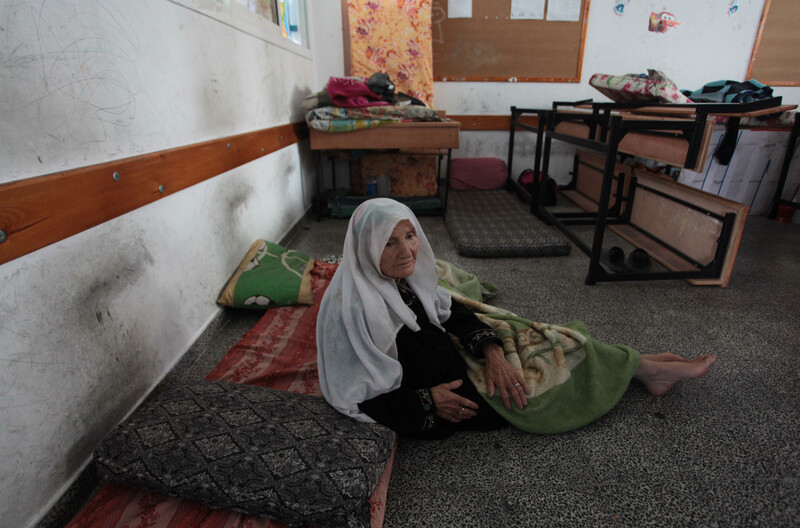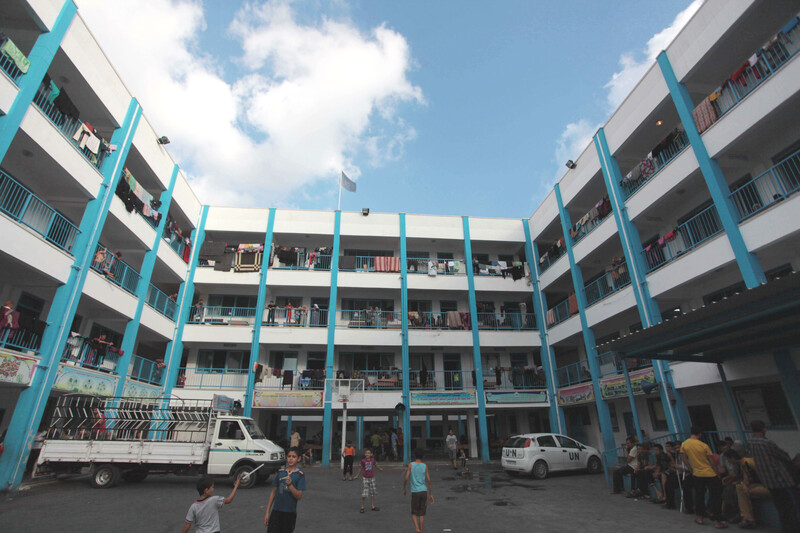The Electronic Intifada Gaza Strip 20 July 2014

As Israel’s attacks intensify, Palestinians fleeing their homes are taking shelter at UN schools.
APA images“It was almost 9am when I was feeding my livestock on my land about three hundred meters from the border, when Israeli army shells began landing heavily on the neighborhood,” Mustafa al-Buhairi told The Electronic Intifada on Saturday.
“It was the first time in the past eight years that my family and I have been forced to flee, in fear of the intensive shelling.”
Along with many other families in the Maghazi refugee camp in the center of the Gaza Strip, al-Buhairi has taken shelter at the preparatory school for girls run by UNRWA, the UN agency for Palestine refugees.
Israel mounted major offensives against Gaza in December 2008-January 2009 and in November 2012.
The current bombardment which began two weeks ago has claimed, by today’s reports, more than 450 lives — the vast majority civilians and about 100 of them children. With more than 3,000 injured, hospitals are struggling to cope.
Now, the number of people fleeing Israel’s attacks has exceeded the number during the 2008-2009 invasion which Israel dubbed “Operation Cast Lead.”
During the early hours of Sunday morning, Israeli occupation forces heavily shelled the Shujaiya neighborhood east of Gaza City, killing at least sixty people and injuring hundreds.
Al-Buhairi said the intensive Israeli shelling is the worst he can remember.
“Despite frequent Israeli attacks in the region, my whole family and I have not even thought of leaving,” he said. “This time is the worst ever. I would like to appeal to the UN’s Secretary General Ban Ki-moon to intervene to stop this madness.”
As Israel escalated its attack, launching a ground invasion three days ago, warplanes have dropped leaflets on the eastern border regions of Gaza warning people to leave their houses.
Recorded phone and text messages were also sent by Israel’s military to thousands of residents in both al-Bureij and Maghazi refugee camps in the central region of the Gaza Strip with similar warnings.
“Staggering” speed
By Saturday, more than 60,000 people had sought shelter in 49 UNRWA schools, the UN reported, exceeding the number sheltered in the agency’s facilities during Operation Cast Lead.
Overall, UNRWA says that 81,000 people are seeking shelter across the Gaza Strip. Some are staying with relatives or even sleeping in the open.

Tens of thousands of Palestinians are seeking shelter at UN installations across Gaza.
APA images“The speed with which this has happened is staggering. The number of displaced persons doubled in one day and more than 25,000 moved to our schools only yesterday,” Director of Operations for UNRWA in Gaza Robert Turner said in a 19 July press statement.
“These men, women and children are relying on us to provide them with shelter, and the reality is that UNRWA only had relief supplies in stock for about 35,000 people,” Turner added.
Ailing mother
As people were flowing into the UNRWA-run girls school in Maghazi, Shadi Misleh, a camp resident, said, “I received a phone call that appears to be a recorded message from the Israeli military warning me to leave for the nearby town of Deir al-Balah.”
“I do not know what I can do — my mother is suffering from respiratory complications and now lives with the help of an oxygen tank,” Misleh said. “I have ordered a number of cabs, yet none agreed to take me and my mother, for fear that the [medical oxygen] tanks will be mistaken by Israeli drones for rockets.”
Another family from Maghazi camp, comprised of eleven members, has also fled Israeli fire. They live about 700 meters from the boundary with Israel.
Ismail Abu Ijlal is a father of nine children, and his entire family are now all taking shelter at the same school.
“Some of their shells landed on my cousins’ houses, forcing us all to leave the area. I have left my car and my house. This is unprecedented and we hope this will end soon, as we no longer feel safe or secure,” Abu Ijlal said.
“I was so frightened after I heard the sound of the bombs. This is the first time that I feel so frightened,” said his 10-year-old daughter, Nida.
Several other schools in Maghazi are also now sheltering hundreds of family members who have fled from the east of the refugee camp.
House “leveled to the ground”
At the UNRWA-run Gaza al-Jadida school on Gaza City’s Nasr street, some 1,400 residents from the northern Gaza region of al-Attatra have been sheltered for more than a week after their neighborhood witnessed fierce Israeli attacks.
Kawkaba al-Attar, an elderly Palestinian woman from the area, was laundering some of her clothes when The Electronic Intifada spoke to her. More than a dozen children were playing in the background.
“We are 23 members of the same family, including my daughter-in-law,” she said. “We have all been displaced over the past week. Our two-story house was leveled to the ground, so we now have no other place to go but this school,” al-Attar said.
More than 1,500 residential units in Gaza have been destroyed, directly displacing more than 9,000 persons, according to the UN. That figure is likely to soar following the overnight shelling in Shujaiya.

The number of displaced persons seeking shelter in Gaza “doubled in one day,” says a UNRWA official.
APA images“I feel pretty disgusted here. A while ago, I wanted to use the toilet, but I felt sick, as it looked very dirty. I wished I would have stayed next to my destroyed home, rather than sitting in this place under these abnormal conditions,” al-Attar added.
UNRWA has announced an emergency action plan and an appeal to raise an emergency fund of $60 million in order to cope with the situation in Gaza.
“We have other concerns about UNRWA facilities. This is a very difficult situation, as this continuous Israeli shelling has grossly damaged the infrastructure,” UNRWA spokesperson Sami Mushasha told The Electronic Intifada. “For example, clean water is being affected, as water treatment plants have been badly impacted and we are now trying to provide fuel for hospitals under a severe electricity shortage.”
The UN’s Office for the Coordination of Humanitarian Affairs (OCHA) says that 900,000 people — half of Gaza’s population — are without adequate water supplies and sanitation services.
Mushasha said that UNRWA’s ability to shelter people was at capacity, and for the time being, the focus is on providing basic food and medical services.
The agency’s job is made more difficult by the fact that its own facilities are vulnerable. At least 56 UNRWA schools and several clinics have been damaged in the bombardment.
Asked whether UNRWA could ask for a humanitarian ceasefire in Gaza, Mushasha said he hoped efforts to achieve a ceasefire would bear fruit soon.
“This must come to an end. There should be a chance to allow these people to live some sort of normality,” he said.
Rami Almeghari is a journalist and university lecturer based in the Gaza Strip.





